- Quick Read
- Deep Read ( 8 Min. )

Why is Christian Science in our name?
Our name is about honesty. The Monitor is owned by The Christian Science Church, and we’ve always been transparent about that.
The Church publishes the Monitor because it sees good journalism as vital to progress in the world. Since 1908, we’ve aimed “to injure no man, but to bless all mankind,” as our founder, Mary Baker Eddy, put it.
Here, you’ll find award-winning journalism not driven by commercial influences – a news organization that takes seriously its mission to uplift the world by seeking solutions and finding reasons for credible hope.
Explore values journalism About usIn Today’s Issue
- Texas National Guard tests state authority on US border
- Today’s news briefs
- Gaza aid workers press on despite Israeli convoy strike
- Sparrows Point helped build the Key Bridge. Its collapse left residents isolated.
- ‘You have to be loving’: The craft of storytelling
- Project ‘Frozen Dumbo’ boosts African elephant populations
Monitor Daily Podcast
- Follow us:
- Apple Podcasts
- Spotify
- RSS Feed
- Download
TODAY’S INTRO
Mutual support in covering aid
Remember “look for the helpers”? Fred Rogers, late champion of childhood innocence, prescribed that activity as a balm for kids shellshocked by news. It got overused, perhaps. One magazine dismissed it as a pat “consolation meme.”
In the context of Gaza, where children have themselves been a large proportion of those killed and facing famine (as are others worldwide), it can help focus thought on aid workers.
Today, part of our remarkable Middle East team sizes up where perilous aid work goes next. Ghada Abdulfattah and Fatima AbdulKarim work in Gaza and the West Bank, respectively. Taylor Luck travels frequently from his base in Jordan and, with editor Ken Kaplan, helps facilitate coverage. All operate with hope, courage, and dedication.
Share this article
Link copied.

Help fund Monitor journalism for $11/ month
Already a subscriber? Login

Monitor journalism changes lives because we open that too-small box that most people think they live in. We believe news can and should expand a sense of identity and possibility beyond narrow conventional expectations.
Our work isn't possible without your support.
Texas National Guard tests state authority on US border
In response to an increase in illegal border crossings, Texas is trying a new, confrontational approach to using its National Guard. We look at how National Guard use has evolved.

-
Henry Gass Staff writer
Shelby Park was once a popular spot for locals. The municipal park in Eagle Pass, Texas, has transformed in recent months in an escalation of Gov. Greg Abbott’s Operation Lone Star, a border security effort now 3 years old. The state’s use of National Guard and other state law enforcement has ratcheted up tensions with the federal government.
The state seized the park from the city unexpectedly in January. Governor Abbott visited in February alongside 13 fellow Republican governors, many of whom are sending members of their National Guard to support Texas’ border initiative. That month former President Donald Trump also praised the state’s “military operation” when he visited Shelby Park.
National Guard deployment to the border isn’t new. For decades, governors and presidents of both parties have called up these troops to support local, state, and federal agencies. What’s new, say legal experts, is a state’s use of the National Guard as an overt political challenge to federal immigration authority.
Texas officials say they’ve taken these actions out of necessity due to the federal government’s neglect of its border security responsibility. The Department of Homeland Security has accused Texas of blocking U.S. Border Patrol agents from accessing and performing their duties in Shelby Park.
Texas National Guard tests state authority on US border
Shelby Park was once a popular spot for locals to play soccer or walk their dogs along the Rio Grande. Today National Guard troops from Texas patrol the park that – now rimmed with spiraled wire – is seen as a front line in a national debate over U.S. border security.
The municipal park in Eagle Pass, Texas, has been transformed in recent months in an escalation of Gov. Greg Abbott’s Operation Lone Star, a border security effort now 3 years old. The state’s use of National Guard and other state law enforcement has ratcheted up tensions with the federal government.
The state seized the park from the city unexpectedly in January, and the Department of Homeland Security accused Texas of blocking U.S. Border Patrol agents from accessing it. Governor Abbott visited in February alongside 13 fellow Republican governors, many of whom are sending members of their National Guard to support Texas’ border initiative. Former President Donald Trump also praised the state’s “military operation” when he visited Shelby Park in February.
National Guard deployment to the border isn’t new. For decades, governors and presidents of both parties have called up these troops to support local, state, and federal agencies. What’s new, say legal experts, is a state’s use of the National Guard as an overt political challenge to federal immigration authority. Dangerous, unlawful border crossings, meanwhile, continue.
“The use of the Guard for things that are customarily federal duties, coupled with the political environment we’re in, coupled with the renewed assertion of states’ rights – to me, it’s more than somewhat problematic,” says Joshua Kastenberg, a former Air Force lawyer and judge, now professor at the University of New Mexico School of Law.
From militias to National Guard
The National Guard, a state-based, reserve U.S. military force, grew out of militias that predated the nation. Congress introduced standardized training and federal funding in 1903, helping transform the National Guard into a modern force. National Guard troops are now deployed regularly across the United States, including for natural disaster response, COVID-19 testing, and recently the patrolling of the New York City subway. Massachusetts activated up to 250 National Guard troops last summer to help migrants access food and medical care at shelters.
Governors, the president, and Congress can all activate the National Guard. The federal government is prohibited from using the National Guard as a civilian police force (unless authorized by the invocation of a law like the Insurrection Act). States, however, generally have more leeway.
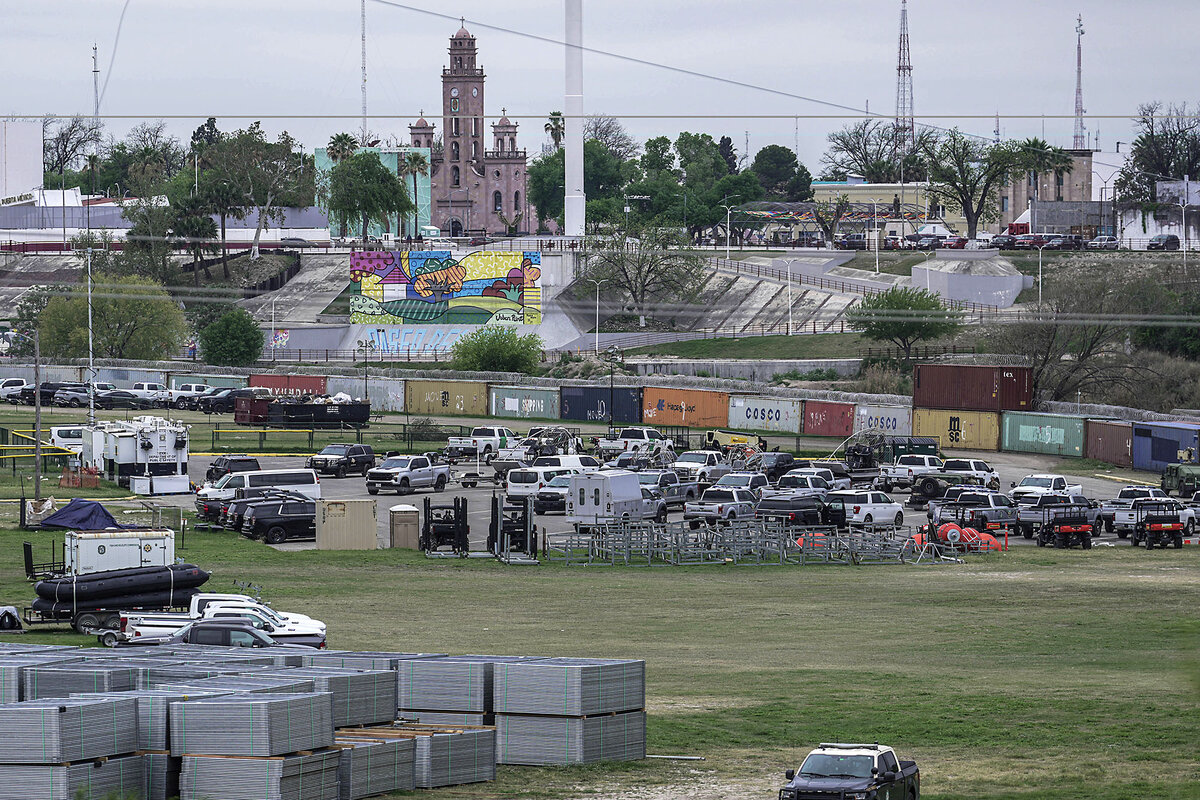
Within a state role, the National Guard has “always been able to support, or even function, in a law enforcement capacity,” says Joseph Miller, senior historian at the National Guard Bureau.
After Border Patrol tracked a record-high number of migrant encounters along the southern border in December, Texas installed itself in Shelby Park the following month. The state refused to comply with a Department of Homeland Security “cease and desist” letter demanding full access, which alleged that the presence of state troops in Shelby Park obstructs federal Border Patrol operations.
Texas’ actions “improperly seek to regulate the federal government,” persisting “even in instances of imminent danger to life and safety,” Jonathan Meyer, general counsel for the U.S. government, wrote in the letter.
Also in January, the Supreme Court sided with the Biden administration in a 5-4 vote, allowing federal agents to cut through state-installed wire in order to perform their duties.
The ruling also left key concerns unanswered around the broader state-federal conflict. The court “could have answered the questions” of whether Texas’ use of its National Guard is unconstitutional, “but courts don’t do those things unless they have to, usually,” says William Banks, professor emeritus at the Syracuse University College of Law.
“No state can use the National Guard in a way that offends the United States Constitution, or the supremacy of federal law,” says Professor Banks. “What’s going on now in Texas, viewed a certain way, is Abbott is interfering in a federal power over immigration.”
Border authority
Texas officials say they’ve taken these actions out of necessity, due to the federal government’s neglect of its border security responsibility. Migrants have crossed illegally in record numbers during the Biden administration, with an average of 2 million annual Border Patrol encounters along the entire southern border since 2021, the highest levels on record.
“Until President Biden steps up and does his job as Commander-in-Chief to secure the border, Texas will hold the line and use every tool and strategy to keep our country safe,” Governor Abbott said in a statement last month.
The Texas governor’s office says the state’s efforts are paying off, citing “over 503,800 illegal immigrant apprehensions and more than 40,400 criminal arrests.” Critics cast Operation Lone Star as ineffective, subject to civil and human rights abuse, and expensive. The first two years of the operation cost around $4 billion, according to news reports. Further appropriations passed by the state legislature could push the state’s border spending to over $11 billion through 2025.
Border Patrol encounters have dropped along the Texas-Mexico border over the last five months compared with the same period last fiscal year, although encounters are rising elsewhere in Tucson, Arizona, and San Diego, California, sectors.
Two-thirds of Texas voters support the deployment of more state police and military resources to the border, according to a February poll. The Texas Military Department did not respond to a request for comment, and U.S. Customs and Border Protection declined to comment on the record.
Along the Texas-Mexico border, the use of state troops expands beyond Eagle Pass.
Further west, on the border in El Paso, a viral video released by the New York Post in March shows a crowd of migrants, several with their hands raised, pushing past Texas National Guard members. (Under U.S. law, individuals may apply for protections like asylum, even if they entered illegally, as a defense against removal.)

To Adolpho Telles, the El Paso County Republican Party chairman, the incident represents an “attack on this country.”
“The Texas National Guard should not have to be doing what they’re doing, but because the president is not living up to his pledge to support the Constitution of the United States, the state of Texas needs to protect its citizens,” says Mr. Telles.
Governor Abbott has also announced plans to build a military-style base to house National Guard troops on 80 acres of land in the Eagle Pass area. The site will be able to hold up to 2,300 service members previously located in hotels around the region. Meanwhile, some locals say the state’s show of force is excessive. They also want their park back.
With Shelby Park generally closed to the public, the Eagle Pass City Council moved their upcoming solar eclipse festival to another venue, according to the Eagle Pass Business Journal. The city’s mayor told local media that the park was taken over by the state without notice or consent.
The saga is emblematic of a broader trend around state challenges to federal authority, says Amerika Garcia Grewal, a local who helps organize vigils at the park that honor migrant lives lost in the Rio Grande.
“It has the potential to tear our union apart,” says Ms. Garcia Grewal. “Here in Eagle Pass, Governor Abbott has found a pressure point, and he’s hammering it on as hard as he can. And he’s sending cracks out throughout the entire United States.”
The Department of Justice has so far resisted suing Texas over its takeover of Shelby Park and restrictions on Border Patrol agents. The Biden administration has considered litigation, but doesn’t want to further escalate conflict, according to NBC News.
Meanwhile, the Biden administration has sued Texas over other efforts to expand state immigration authority. Litigation is ongoing over a buoy barrier installed by Texas in the Rio Grande, and a new law that would permit state officials to arrest and deport migrants who crossed the border illegally.
“Let’s ... put the guardsmen in there”
Texas isn’t alone in calling up its National Guard to manage its border. Arizona Gov. Katie Hobbs in December authorized the state National Guard to assist border counties with fentanyl and human trafficking enforcement. “Arizona has borne the burden of federal inaction in managing the State’s southern border,” the Democratic governor wrote in an executive order.
“We’re ready to support as long as needed,” says Capt. Erin Hannigan, spokesperson for the Arizona National Guard. The length of time depends on the “governor’s office and the counties that are requesting this support.”
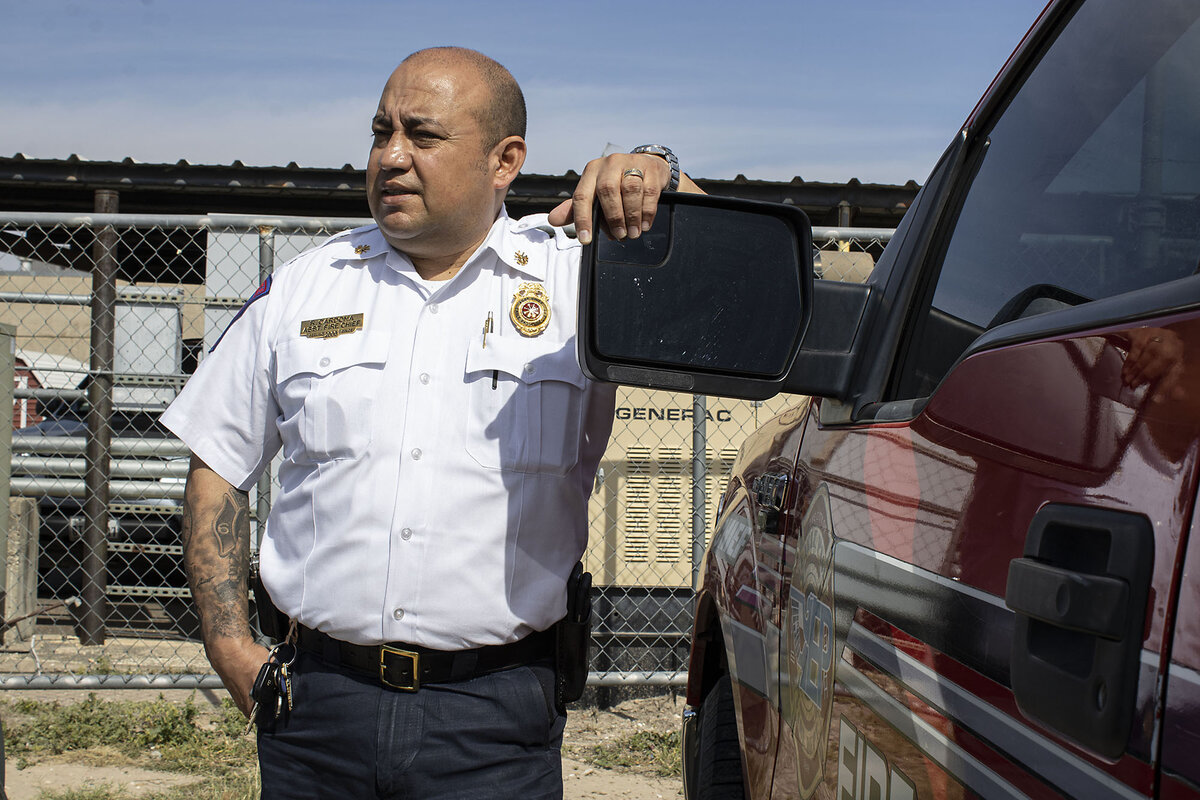
For this fiscal year, the Department of Defense has also authorized the use of up to 2,500 National Guard troops to support federal immigration authorities along all four southern border states, mobilized from around half of all U.S. states and Guam. These border missions have been exercised by both red and blue commanders in chief.
“It’s nothing new,” says Victor Manjarrez Jr., director of the Center for Law and Human Behavior at the University of Texas at El Paso and a retired Border Patrol official.
For instance, starting in 2006, Dr. Manjarrez recalls coordinating up to 6,000 National Guard troops at the southern border under Operation Jump Start. Launched by Republican President George W. Bush, the mission aimed to offset a deficit of Border Patrol agents, he says, by placing the National Guard in roles that didn’t involve patrolling the border.
“We took a good count of, ‘hey, what [Border Patrol] agents are doing nonagent things’” like vehicle maintenance, for example, he says. “Let’s get the agents out in the field; put the guardsmen in there.”
Local first responders
Back in Eagle Pass, state and federal personnel are not the only ones patrolling the Rio Grande. Local first responders also run their own missions. Eagle Pass emergency management services can still access the river, yet state-installed barriers along the banks mean that missions, including medical aid for those injured or body recovery for those who died, take longer, says Rodolfo Cardona, assistant fire chief.
The city’s emergency management coordinator stresses that, politics aside, the humanitarian crisis at the border continues. So does the mental health toll that his workers – and law enforcement – have increasingly borne while responding to illegal crossings. The crisis includes migrant children found injured, beaten, and raped.
“I don’t think it was ever a priority on our federal government’s mind – of the aftermath, and the toll it takes on not only us, but Border Patrol, the military, and everybody else,” says Mr. Cardona.
“All of this is tragic, in more ways than one,” he says. “These are human beings.”

Today’s news briefs
• Was airstrike a war crime? Human Rights Watch says an Israeli strike on an apartment building in Gaza last October killed at least 106 civilians, including 54 children, and that its investigation found no legitimate military target.
• Israel ousts officers over drone attack: Its military dismisses two and reprimands three others for their roles in Gaza strikes that killed seven aid workers on a food-delivery mission by World Central Kitchen.
• Women’s Final Four set: Caitlin Clark and Iowa are in it. So are Dawn Staley and South Carolina. UConn and NC State are, too. The women’s college basketball world descends on Cleveland for the national semifinals April 5 and the championship game two days later.
• Iran vows retaliation: The commander of Iran’s Islamic Revolutionary Guard Corp. escalates threats of retaliation against Israel for another airstrike – one on the consular section at the Iranian embassy in Syria that killed seven of the group’s members, including two Iranian generals, this week.
• Eclipse-watchers watch weather: Clouds could obscure views of the total solar eclipse April 8 in some parts of North America. Meteorologists predict clouds in many locations along the eclipse’s path, including parts of Ohio, Pennsylvania, New York, and Texas.

Gaza aid workers press on despite Israeli convoy strike
As international aid agencies pull back in Gaza after the drone strike on a World Central Kitchen convoy, a heavier burden falls on local humanitarian workers. Their determination to save lives helps them persevere.

- Quick Read
- Deep Read ( 6 Min. )
-
By Ghada Abdulfattah Special contributor
-
Taylor Luck Special correspondent
Local humanitarian workers in the Gaza Strip, who lack the protections of international organizations, have been left shaken by the lethal Israeli drone strikes on the World Central Kitchen staff, whom they had befriended. And they say a suspension in operations by aid agencies in Gaza poses more obstacles to their mission.
“The airstrike on the WCK convoy elicited a range of emotions: fear, sadness, and outrage,” says Aisha Salem, a manager at the Economic & Social Development Center of Palestine, a nongovernmental organization that distributes food parcels in southern Gaza. “It underscores the serious risks we face daily as we carry out our mission to alleviate suffering and provide aid to those in dire need.”
On Friday came signs some relief could be on the way, as Israel said it was opening a border crossing with northern Gaza and allowing the port of Ashdod to receive Gaza-bound aid. Norwegian Refugee Council Secretary-General Jan Egeland welcomed what he called a “watershed moment.”
Yet the dangers to aid workers remain, as do their concerns.
“The urgency of the situation and the pressing needs of vulnerable populations compel us to push through our fear,” says Ms. Salem. “We are determined to make a difference.”
Gaza aid workers press on despite Israeli convoy strike

The shock waves of the lethal Israeli military strike on a World Central Kitchen convoy are creating fresh obstacles for humanitarian workers in Gaza who continue to fight famine even as they themselves are at risk.
The local humanitarian workers, who lack the protections of international organizations, have been left shaken by the strikes on the WCK staff, whom they had befriended. They say a suspension in operations by aid agencies in Gaza poses more obstacles to their mission.
“The airstrike on the WCK convoy elicited a range of emotions: fear, sadness, and outrage,” says Aisha Salem, a manager at the Economic & Social Development Center of Palestine, a Palestinian nongovernmental organization that distributes food parcels in southern Gaza. “It underscores the serious risks we face daily as we carry out our mission to alleviate suffering and provide aid to those in dire need.”
On Friday came signs some relief could be on the way.
Following a tense phone call between President Joe Biden and Prime Minister Benjamin Netanyahu, Israel announced a “temporary opening” of the Erez Crossing with northern Gaza and the use of the port of Ashdod to receive Gaza-bound aid, with the potential to massively increase food and assistance to the besieged strip.
Also Friday, Israel announced that two officers – a colonel and major – had been sacked, and three others including a general had been reprimanded, following a preliminary military investigation into the drone strikes on the convoy.

Norwegian Refugee Council Secretary-General Jan Egeland, in an interview with BBC World Service Radio, described the temporary border opening as a “watershed moment.”
“I think it’s a turning point, and I think the aid will flow freely,” he said. “I’m glad the most recent tragedy [the WCK incident] has woken up the capitals of the West. I think they [Israelis] have understood that their current policy is counterproductive.”
Yet international NGOs operating in Gaza expressed caution, stressing that the issues of security, coordination with the Israeli military, and a cumbersome screening process imposed by Israel that has slowed aid to a trickle have yet to be resolved.
And the dangers to aid workers remain.
Groups suspend work
In the wake of the killing of one Palestinian and six international aid workers in marked WCK vehicles, the charity suspended its operations in Gaza, citing Israel’s inability to ensure its staff’s safety.
A ship laden with 240 tons of Gaza-bound WCK aid was turned back to Cyprus. In five months, the agency had delivered more than 40 million meals across Gaza.
American Near East Refugee Aid, which was serving 150,000 meals per day across Gaza, also halted its operations this week.
According to one humanitarian coordinating the international aid response in Gaza, more international organizations in Gaza “are considering suspension” in wake of the strike, with the full impact on international aid agencies’ work in Gaza yet to be felt.
The reduced activity makes the efforts of Palestinian men and women still trying to keep their communities alive more difficult – and more vital.
Ahmed Abu Sultan, a project coordinator at the Wefaq Association for Women and Child Care, a local charity that partnered with World Central Kitchen, would go to the WCK storage facility in Rafah twice weekly to load his truck with rice, cooking oil, and lentils to then prepare hot meals that would be packaged and distributed across Rafah.

There he befriended Australian Zomi Frankcom, one of the seven killed in the Israeli strike, whom he described as a “dynamo” full of positivity with a contagious smile.
“Seeing international organizations in Gaza gave us some comfort,” he says. But their killing “shook us. Some volunteers stopped coming out of fear of being attacked. People with foreign nationalities have been killed. This means that I can easily get killed” as a local NGO worker, he says they reason.
With the WCK suspending its work, Mr. Abu Sultan now relies on two smaller donor organizations, cutting back on Wefaq’s meal service.
“I am afraid that this will affect our kitchen’s operations. This will reduce the number of hot meals we produce for displaced and needy people in the Gaza Strip,” he says.
UNRWA teams “terrified”
UNRWA, the largest humanitarian organization on the ground in Gaza, has had 176 staff members killed in the war, many in the line of duty – the most United Nations staff killed in any conflict.
“Our teams are absolutely terrified,” says UNRWA spokesperson Juliette Touma. “What happened is a testament that no one is safe in Gaza even if you are an aid worker wearing your gear, driving a marked car in a coordinated deconflicted route. You are not safe.”
UNRWA convoys have twice been hit when attempting to reach northern Gaza on a prescribed secure route.
“We had hoped foreign nationals would be able to provide aid to us without being exposed to the dangers by the Israeli military,” says Fatema Abu Atta, program officer at Aisha Society, a women’s organization that provides family support services.
“The killing of WCK workers has shaken my confidence in international humanitarian law,” Ms. Abu Atta says. “It all seems to be one big lie.”
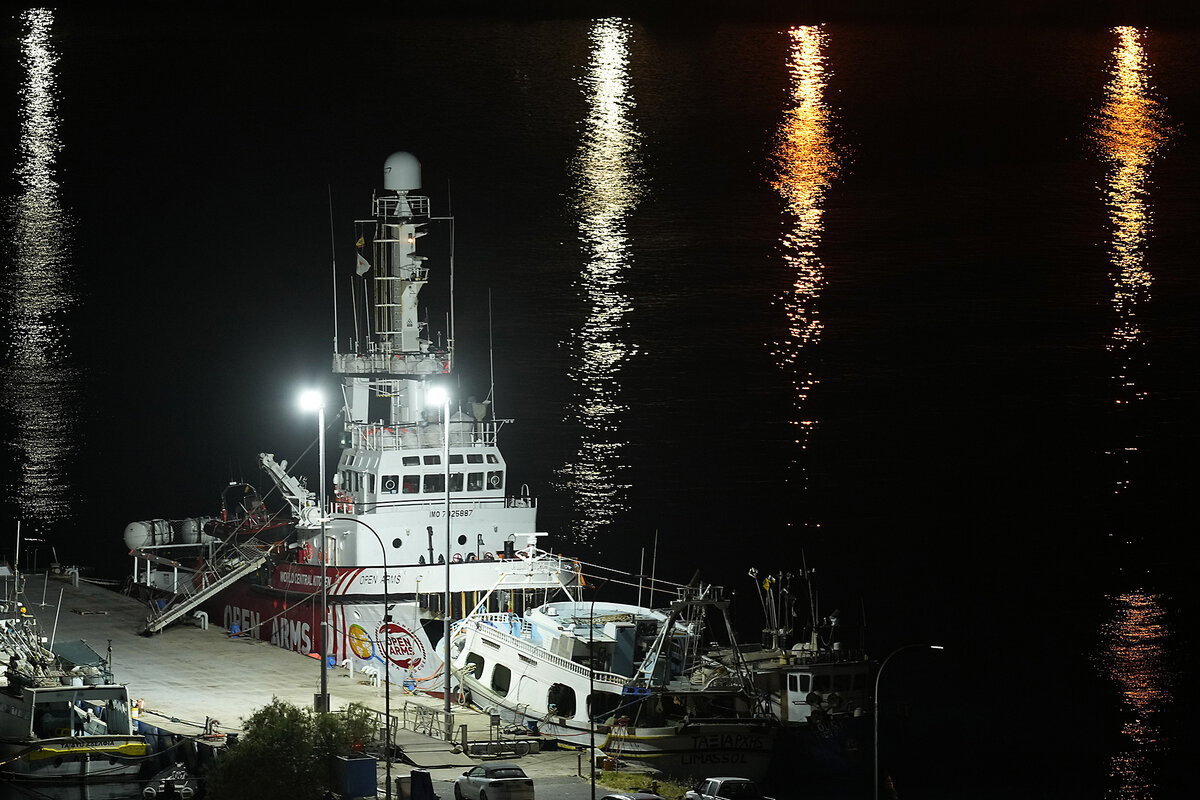
Mohammed Nairab, director of Palestinian Environmental Friends, currently handing out food parcels to displaced families in camps along Gaza’s coast and in Rafah, says Tuesday’s strike “highlights the urgent need for increased protection of humanitarian workers.”
Without protective gear or armored cars, the most dangerous part of the job distributing aid, the workers say, is traveling on roads and through neighborhoods that can be hit with missiles or shelling at any moment.
While international organizations like the WCK have deconfliction arrangements and share the coordinates of their movements with the Israeli military, Mr. Abu Sultan, and many humanitarian workers like him, use public transportation every day.
Lives “shattered daily”
Also daunting, the local aid workers say, is the constant anxiety and worry over the safety of their loved ones in evacuee centers and tents.
“The decision to leave my family behind to assist those in need weighs heavily on me,” says Mr. Nairab.
Many local humanitarian workers and U.N. staff have lost family members to Israeli missile strikes, but they continue their work.
Their own safety, the workers stress to the Monitor, is a secondary concern.
Their priority: fighting against famine and a humanitarian situation deteriorating by the hour, a race against the clock to save whomever they can.
“Lives are being shattered daily, and the humanitarian crisis deepens with each passing moment,” says Mr. Nairab. “Urgent action is needed to ensure the timely delivery of assistance to save lives.”
“The urgency of the situation and the pressing needs of vulnerable populations compel us to push through our fear,” adds Ms. Salem, the Palestinian NGO manager. “We are determined to make a difference.”
“These are people who have lost families, homes, they fear for themselves and their children, and yet they still continue to risk their lives to deliver babies, [and] hand out medicine and bags of flour,” says UNRWA’s Ms. Touma. “These are heroes.”
Fatima AbdulKarim contributed to this report from Ramallah, West Bank.

Sparrows Point helped build the Key Bridge. Its collapse left residents isolated.
Sparrows Point was a company town that lost its iconic company but persevered. Now, the collapse of the Francis Scott Key Bridge has left residents feeling cut off on the north side of the harbor, wondering what the future may hold for their home.

- Quick Read
- Deep Read ( 7 Min. )
Andrew Morton stood in the sun on the smokestacks of a blast furnace the day the Francis Scott Key Bridge opened on March 23, 1977, watching the first cars cross the bridge. One of many steelworkers at the Bethlehem Steel Corp. at the north end of the bridge, he’d surely forged some of the metal.
Forty-seven years later, Mr. Morton woke up on March 26 to videos he couldn’t believe. The Key Bridge had collapsed after it was hit by a cargo ship.
Not only did Mr. Morton and other residents of Sparrows Point play a role in building the bridge, but also it’s what connected them to the other side of the Baltimore harbor. The town’s roots are inextricably linked with the history of Bethlehem Steel, a manufacturing titan at its height in the 20th century. For over a century it powered the local community, building a company town.
With the wreckage of Key Bridge, Sparrows Point has reentered the spotlight. Today the mill is gone, replaced by warehouses for Amazon, Under Armour, and McCormick. As the economic powerhouses driving the region shifted, so did the community ethos. Still central to that is the legacy of Bethlehem Steel, which helped build World War II ships and iconic landmarks like the Golden Gate Bridge.
Sparrows Point helped build the Key Bridge. Its collapse left residents isolated.
Andrew Morton stood in the sun on the smokestacks of a blast furnace the day the Francis Scott Key Bridge opened on March 23, 1977, watching the first cars cross the bridge. For him, the moment had a profound resonance. One of many steelworkers at the Bethlehem Steel Corp. at the north end of the bridge, he’d surely forged some of its metal.
Forty-seven years later, nearly to the day, Mr. Morton woke up on March 26 to videos he couldn’t believe. The Key Bridge had collapsed after it was hit by a cargo ship. “I could not believe that within seconds it was up, and within seconds it was down,” says Mr. Morton.
Not only did Mr. Morton and other residents of Sparrows Point play a role in building the bridge, but also it’s what connected them to the other side of the Baltimore harbor. The town’s roots are inextricably linked with the history of Bethlehem Steel, a manufacturing titan at its height in the 20th century.
Mr. Morton was hired by Bethlehem Steel on June 25, 1970. At its height, the mill on Sparrows Point employed 31,000 people. He was signing on to a legacy company in a town with a rich history. Construction on the mill began in 1887, built on a salt marsh. For over a century it powered the local community, building a company town modeled after the industrial towns of New England. Schools, stores, a hospital, even a police force – everything was operated by the mill. Mr. Morton planned to work there for only one summer. He stayed over 40 years.
With all eyes on the wreckage of Key Bridge, Sparrows Point has reentered the spotlight. Today the mill is gone, replaced by warehouses for Amazon, Under Armour, and McCormick & Co. As the economic powerhouses driving the region shifted, so did the community ethos. Still central to that is the legacy of Bethlehem Steel, at one point the largest steel mill in America, which helped build World War II ships and iconic landmarks like the Golden Gate Bridge.
The history of the community forged by Bethlehem Steel is more than one of camaraderie and grit. It’s also one of civil rights struggles and unionizing. And its evolution from a past built from steel to a more uncertain future – from an economy founded on building stuff to one powered by buying stuff – is one that will echo with hollow familiarity in former manufacturing centers all over the United States.
“Baltimore has a reputation as an industry town and as a manufacturing town. But fundamentally, we’re a port town, and that’s one thing that the bridge’s collapse has really driven home,” says Anita Kassof, executive director of the Baltimore Museum of Industry.
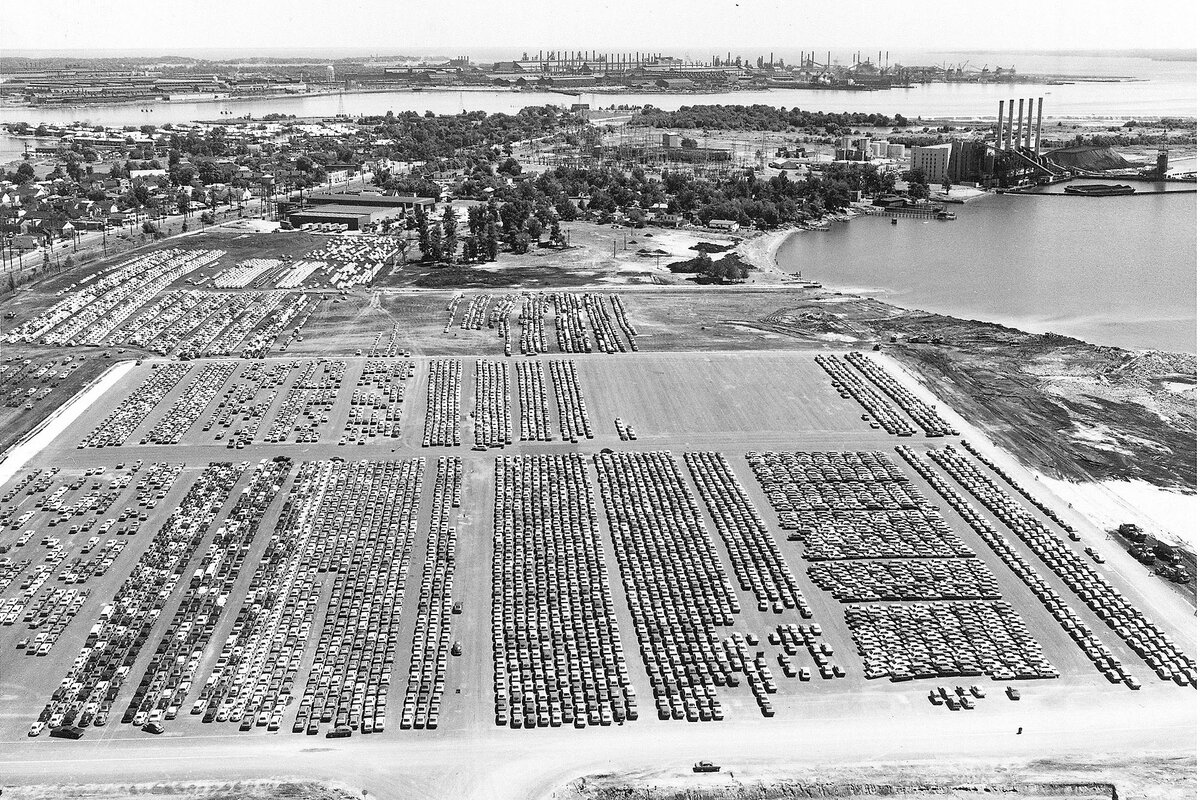
Sparrows Point “was an absolutely self-contained town, segregated by economics and race. But it was such that the families of the mill workers were right there. So it really was like a family, both metaphorically and in fact,” says Ms. Kassof.
The company town was demolished in the 1970s, and employees of Bethlehem Steel were left to relocate themselves. The land has long been redeveloped with small homes on winding streets in Edgemere, a neighborhood locals include in Sparrows Point. A wooded state park covers a stretch of coastline. The town is home to a dollar store, a senior center, and a handful of bars and restaurants. Across the creek is Turner Station. Bethlehem Steel’s Black employees lived in the neighborhood of small brick row houses during the decades when the work crews and neighborhoods were segregated, something Mr. Morton recalls.
“Everybody used to work at the mill”
Though the mill closed in 2012, many residents of Sparrows Point and Turner Station worked there or have family members who did. “Everybody used to work at the mill,” says Jim Rehak, a contractor from Sparrows Point.
Kimberly Schoeberlein and her husband live on a street in Edgemere named after her husband’s family. His grandfather was a heater at Bethlehem Steel.

The Key Bridge was another point of local pride. When it collapsed last week, it felt personal to many here – and its absence has isolated them. Mr. Rehak commutes across the harbor for a job in Annapolis. It now takes him nearly twice as long.
“We lost a major artery to get to the rest of the world,” says Ms. Schoeberlein. “It feels like we’re disconnected.”
A real estate agent in Sparrows Point, she has already spoken to people concerned about property values and some considering moving across the harbor.
The bonds have remained strong for Mr. Morton and other former Bethlehem Steel employees who still live in Sparrows Point and Turner Station. Mr. Morton, in particular, has never strayed far from the legacy of the mill. In the 1990s, he took a computer science college class. He learned coding and built a training module that the company paid to use for new workers – making him a union worker with an outside contract. Since the mill closed, Mr. Morton, who has a photographic memory and used to stay after work to sketch machines, built a complete virtual reality model of the mill, down to the nuts and bolts.

He and others also remember the less idyllic parts of the past – the racism and segregation.
“I wasn’t the typical ’60s and ’70s Black employee,” says Mr. Morton. “I would never have been able to handle the discrimination that those guys had to take.”
Mr. Morton’s own relationship with his fellow steelworkers was often mentor-mentee. “Some of those guys took me under their wing and became like fathers to me.”
“I think we’re going to lose our little town”
Bill Barry, a retired labor studies professor and local historian, has interviewed more than 100 former steelworkers. They were divided evenly on whether they would want their children to work there. “Your grandfather worked there; your father worked there; you could work there,” he says.
That sense of pride mixed with resentment for some when the company declared bankruptcy and finally closed.
“They all went to the same schools; they went to the same churches. It was a traditional American industrial community,” says Mr. Barry. “Everybody knew everybody around, and I don’t think that’s true anymore. Communities have fractured.”
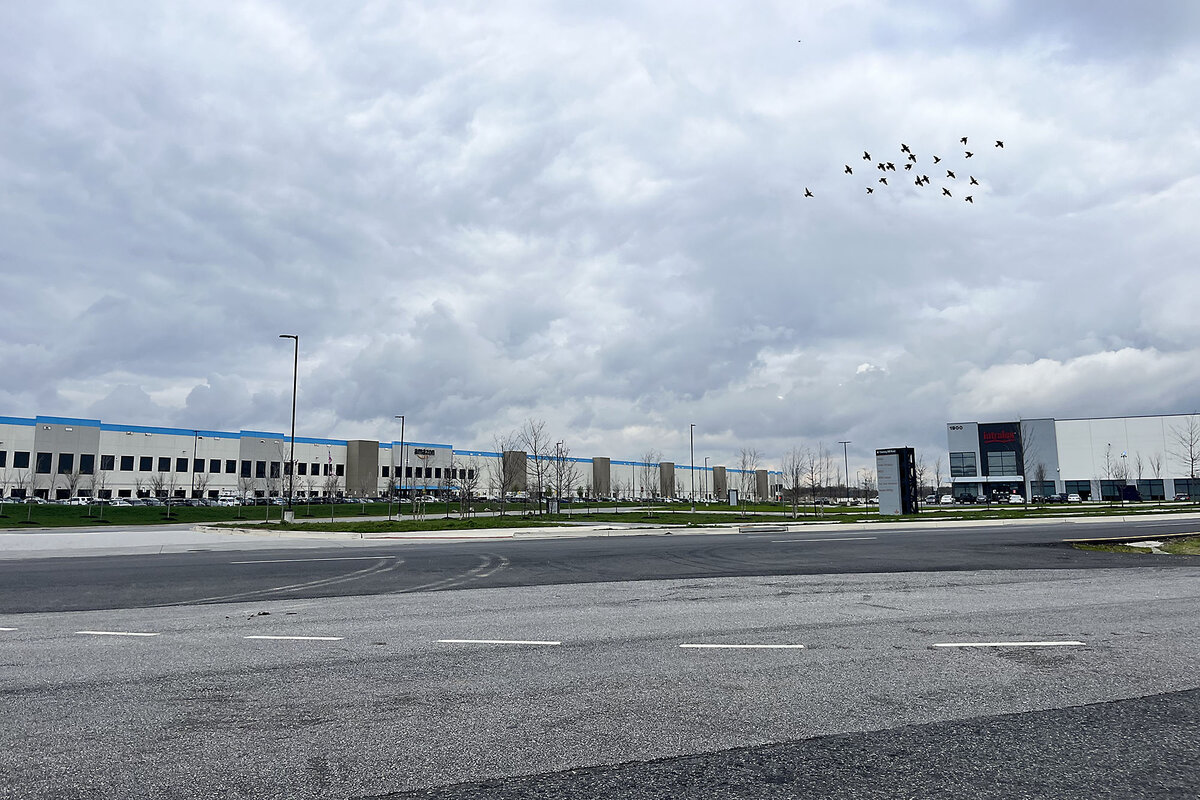
To some, like Mr. Morton, the departure of the mill has contributed to a loss of local identity. Darlene Lumpkin, who grew up in Sparrows Point, sees a similar pattern. She loves the area, calling it her “Mayberry,” but traffic and redevelopment feel like they’re taking over. “I think we’re going to lose our little town,” she says.
Baltimore is the westmost port on the East Coast, says Ms. Kassof. The companies now operating out of Sparrows Point – which also include FedEx and Harley Davidson – require a different type of labor and produce a different product, she notes. But they chose the location for many of the same reasons as Bethlehem Steel: the deepwater port and easy access to roads and railroads headed to the Midwest.
In all, more than 12,000 people work at the warehouses and other businesses that occupy the old mill site.
The flavor of Sparrows Point, no longer loyal to a single employer, is changing. “The steel industry was incredibly skilled,” says Mr. Barry. “People were proud of it. I’m not sure that the work that’s there now has that kind of skill.”
The Schoeberleins used to be able to see the bridge from their bedroom window. Today, the empty sky is a constant reminder that, at least for now, they’re isolated. The collapse of the Francis Scott Key Bridge has turned their focus even more to their immediate community. Ms. Schoeberlein sits on a local business owners board, where members are trying to anticipate needs that Sparrows Point might fill or ways the community could adapt to a possible influx of workers here to rebuild the bridge.
For Mr. Morton, it was his fellow steelworkers who first made him feel like this was his home. “The guys that trained me – I call them my blast furnace fathers,” he says.
They were bonded by a shared sense of danger, thrill, and pride. “We workers had that feeling of a kind of invincibility – that we were the big boys on the block and no one could topple us,” he says. “I remember older workers telling me, ‘Maryland can’t survive without Bethlehem Steel.’”


Podcast
‘You have to be loving’: The craft of storytelling
In personal essays as in news reports, Monitor writers look for the humanity that lies at the heart of the story. A veteran editor of The Home Forum who’s now a regular contributor joins our podcast to talk about his creative take on that work.

What’s the key to telling stories that grip readers and don’t let go?
“Finding the humanity,” says Owen Thomas. “It’s everywhere. You just have to open your eyes to it.” Owen edited The Home Forum section for the Monitor, and nurtured its contributing essayists, for decades before his recent retirement. Now he writes for the section’s new editor, Husna Haq.
“You have to be ready to capture [the humanity], too,” Owen says on our “Why We Wrote This” podcast. He stays armed with a set of 3-by-5 cards for notes. Some of his work draws on fresh observations, some of it on poignant remembrance.
Owen recently wrote about being a middle school stagehand, watching an eighth grade actor pluck victory from potential embarrassment. (It’s worth reading.) “I’m sure nothing else [ever] fazed her,” he says of the young star.
“I think the key for me and for anyone writing an essay is to be true to your experience, ” Owen says. “You have to be honest. I think you have to be loving. And I think to be truly honest is to be loving.”
“You have to look deep into what you are and what you’ve experienced,” he says. “It’s amazing what you’ll find.” – Clayton Collins and Mackenzie Farkus
Find more links and a transcript here.
Telling Stories Readers Can’t Resist

In Pictures
Project ‘Frozen Dumbo’ boosts African elephant populations
At their best, zoos inspire a conservation mind-set among visitors. But many European facilities populate exhibits with elephants taken from the wild. One international project offers an alternative.

- Quick Read
- Deep Read ( 3 Min. )
-
By Matjaž Krivic Contributor
-
Boštjan Videmšek Contributor
Poaching, habitat destruction, and climate change have decimated wild African elephant populations and pushed the animals into endangered-species territory. An international project called Operation Frozen Dumbo aims to bolster elephant populations in the wild and in the world’s zoos.
Above a herd of elephants in the Selati Game Reserve in South Africa, helicopter pilot Jana Meyer and wildlife veterinarian Hayden Cuthill scan the bush for the most worthy-looking bull elephant. Once their target is selected, Ms. Meyer deftly maneuvers her aircraft to separate the animal from the herd. Dr. Cuthill quickly estimates the male’s weight and prepares the tranquilizer dose. He fixes the ampul atop a special dart, which he shoots directly into the male’s left flank.
A team on the ground will collect the elephant’s sperm as part of the Frozen Dumbo project. The samples collected in the wild are cryogenically frozen and shipped to a consortium of European zoos, which use them to artificially inseminate their females.
Thomas Hildebrandt of the Leibniz Institute for Zoo and Wildlife Research, who has overseen the successful artificial insemination of more than 50 female elephants, is passionate about his goal: “We have to stop populating the European zoos with animals from the wild.”
Project ‘Frozen Dumbo’ boosts African elephant populations
Above a herd of elephants in the Selati Game Reserve in South Africa, helicopter pilot Jana Meyer and wildlife veterinarian Hayden Cuthill scan the bush for the most worthy-looking bull elephant.
Once their target is selected, Ms. Meyer deftly maneuvers her aircraft to separate the animal from the herd. Dr. Cuthill quickly estimates the male’s weight and prepares the tranquilizer dose. He fixes the ampul atop a special dart, which he shoots directly into the male’s left flank.
A team on the ground will collect the elephant’s sperm as part of an ongoing international effort to improve elephant fertility, a project called Operation Frozen Dumbo. The samples collected in the wild are cryogenically frozen and shipped to a consortium of European zoos, which use them to artificially inseminate their females.
This avoids the importation of wild elephants.
Factors such as poaching, habitat destruction, and climate change have decimated wild African elephant populations and pushed the animals into endangered-species territory. The Frozen Dumbo project aims to bolster elephant populations in the wild and in the world’s zoos.
Back at Selati, the sedated male – dubbed The Sperminator – issues a series of loud grunts. A volunteer keeps the tip of his trunk dilated with a wooden stick to ensure the animal’s breathing.
Elephants draw air exclusively through their trunks, so if anything blocks this double-channel pathway, the animal could quickly die. Elephants cannot breathe through their mouths like other land mammals – a trait inherited from their aquatic ancestors.
This is the fifth day of the Selati sperm-collecting expedition, which has been largely unsuccessful.
Everyone on the team is relieved when an ultrasound performed by the project’s lead scientist, Thomas Hildebrandt of the Leibniz Institute for Zoo and Wildlife Research, shows the animal’s reproductive potential to be high. His semen is extracted into vials that will then be flown by helicopter to a field lab to be gradually frozen. These will be shipped to a cryobank at ZooParc de Beauval in France.
Dr. Hildebrandt, who has overseen the successful artificial insemination of more than 50 female elephants, is passionate about his goal: “We have to stop populating the European zoos with animals from the wild,” he says. “Instead, we only need to import the sperm and the egg cells.”

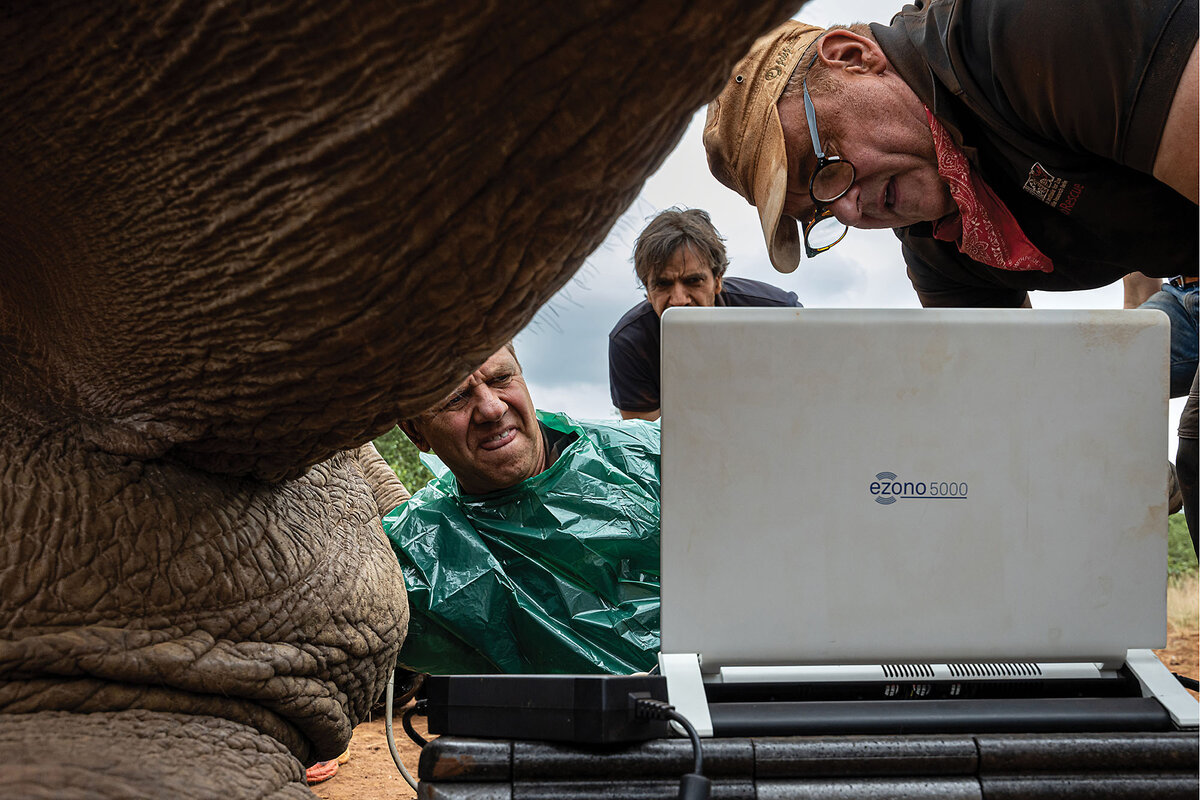

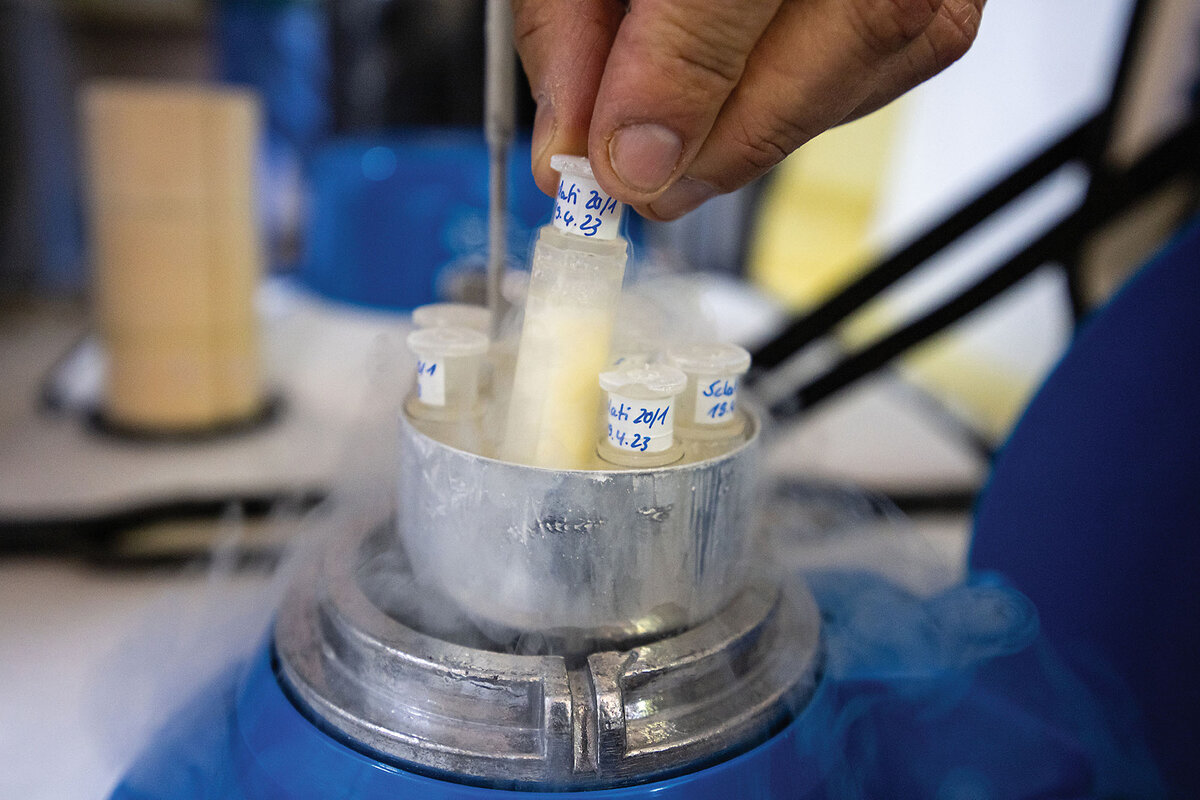
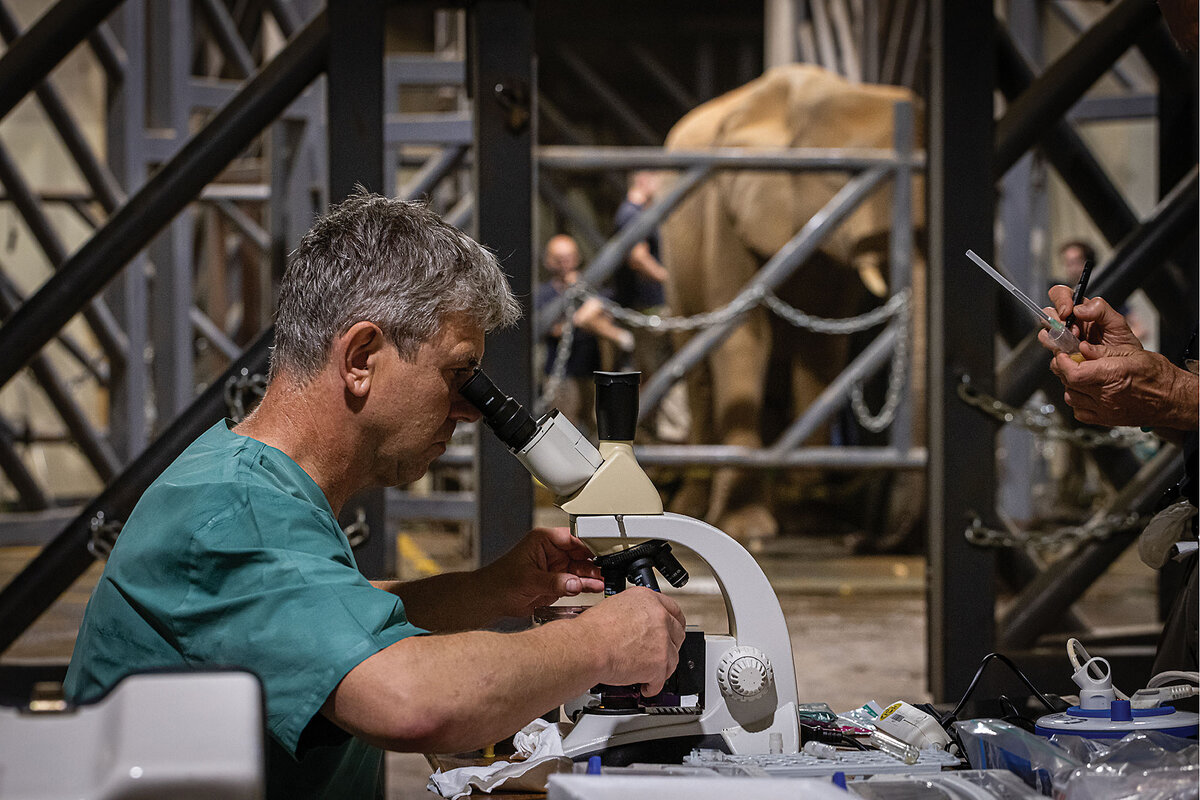
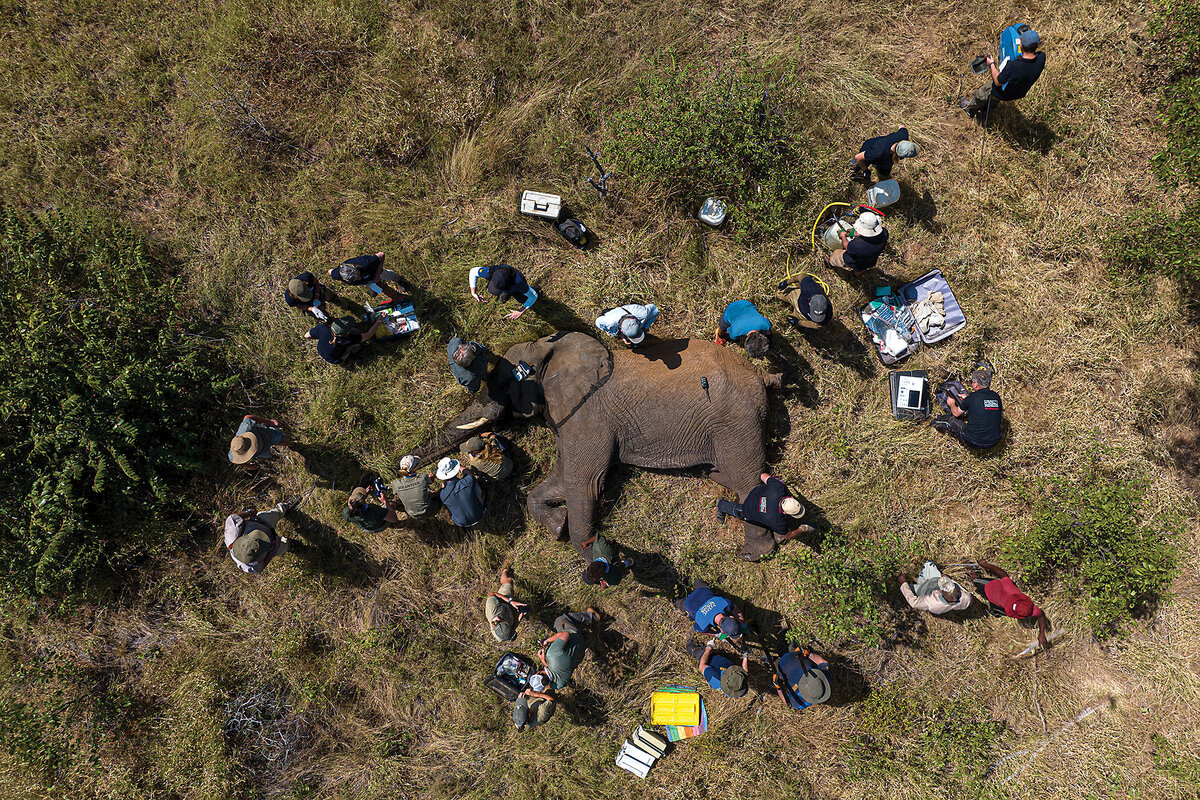

Other headline stories we’re watching
(Get live updates throughout the day.)The Monitor's View
What an eclipse brings to light
- Quick Read
- Deep Read ( 3 Min. )
-
By the Monitor's Editorial Board
Like peas in a pod, the sun, moon, and Earth will line up April 8 to cast a 115-mile-wide shadow moving from Texas to Maine. The rare solar eclipse is expected to bring more people together than the Super Bowl. Small towns are putting on their best hospitality for millions of visitors from the cities. In Ohio, the Knox County Association for Remarkable Citizens plans to bring together people with and without disabilities for an inclusive community experience (picnic included).
For just a few minutes, a cosmic spectacle across North America will create a great mingling of diverse strangers. Political divisions will seem trivial compared with the heavenly wonder. “This year’s eclipse, I pray, just might nudge our fractured nation in a hopeful, unified direction,” wrote David Baron, former chair in astrobiology at the Library of Congress.
This moment of a cohesive America, however, may reflect a reality that itself is often eclipsed by politics and the news media. Americans actually have a pretty faulty belief that they are more divided than they are told, according to deep-dive surveys of private opinion by the think tank Populace.
What an eclipse brings to light

Like peas in a pod, the sun, moon, and Earth will line up April 8 to cast a 115-mile-wide shadow moving from Texas to Maine. The rare solar eclipse is expected to bring more people together than the Super Bowl or perhaps the Fourth of July. Small towns are putting on their best hospitality for millions of visitors from the cities. In Ohio, the Knox County Association for Remarkable Citizens plans to bring together people with and without disabilities for an inclusive community experience (picnic included).
For just a few minutes, a cosmic spectacle across North America will create a great mingling of diverse strangers. Political divisions will seem trivial compared with the heavenly wonder. “This year’s eclipse, I pray, just might nudge our fractured nation in a hopeful, unified direction,” wrote David Baron, former chair in astrobiology at the Library of Congress, in The Washington Post.
The awe of an eclipse is known to elicit the best in viewers – who wear the proper shaded glasses. A study of a 2017 eclipse in the United States by the University of California, Irvine found people were less self-focused, more social, and more humble, based on social posts at the time.
This moment of a cohesive America, however, may reflect a reality that itself is often eclipsed by politics and the news media. Americans actually have a pretty faulty belief that they are more divided than they are told, according to deep-dive surveys of private opinion by the think tank Populace.
“Across race, gender, income, education, generation, and 2020 presidential vote, there is stunning agreement on the long-term national priorities that Americans believe should characterize America,” Populace has found.
There is remarkable consensus on priorities such as health care, community safety, criminal justice reform, and infrastructure. Action on climate change is ranked third in priorities; yet when asked what most other Americans would believe, people say climate action only ranks 33rd.
In other words, on many issues, there is a false polarization that could evaporate with more honesty. That’s not the case on a few issues, such as illegal border crossings, abortion, and a living wage. Yet somehow, Americans just do not realize that other people want most of the same things that they want.
“We have this sense of our civil society sort of breaking down and that maybe people just don’t care anymore, and it’s not true,” Todd Rose, CEO of Populace, told the Class Disrupted podcast. “I just don’t see how we solve our problems when we’re keeping quiet about the things that matter most to us.”
The Populace surveys find Americans choose character attributes over public status. By a supermajority, they want to be involved in a community – even if only a third are engaged in their community at the level they want.
Perhaps it takes the shared experience of a solar eclipse to shed light on what Americans share in values and interests. People do really want to get along. For a few minutes on April 8, they will see how it can be done.

A Christian Science Perspective
Each weekday, the Monitor includes one clearly labeled religious article offering spiritual insight on contemporary issues, including the news. The publication – in its various forms – is produced for anyone who cares about the progress of the human endeavor around the world and seeks news reported with compassion, intelligence, and an essentially constructive lens. For many, that caring has religious roots. For many, it does not. The Monitor has always embraced both audiences. The Monitor is owned by a church – The First Church of Christ, Scientist, in Boston – whose founder was concerned with both the state of the world and the quality of available news.
Always at home
- Quick Read
- Read or Listen ( 4 Min. )
-
By Melissa Swazey Kelly
When we set aside a material concept of home for a spiritual view, we find there’s no limit to the harmony we can experience.
Always at home
One day as I was leaving work, I found myself thinking, “I can’t wait to get home!” I wanted to feel more comfortable – to feel like myself – and I raced home to my apartment to do it. Then I began to wonder, “Why do I have to be at home to feel more like me?”
In its best sense, the idea of home evokes feelings of being comforted, appreciated, known, safe, and deeply loved and cared for. But what if you lost your home? What if you were between homes? Would you then be denied all the wonderful qualities associated with home? The concept of home must have a deeper significance and a more enduring nature.
As a student of Christian Science, I had learned that the source of all good is God. I reasoned that therefore the good qualities of home must actually have their source in God. And because God is divine Spirit, they must be as spiritual and enduring as God Himself is, and must be available to everyone at all times.
I felt the need for still deeper insight and was led to turn to the Christian Science textbook, “Science and Health with Key to the Scriptures” by Mary Baker Eddy. This book, which elucidates the spiritual sense of the Bible, offers a spiritual interpretation of the 23rd Psalm. On page 578 the author takes us line by line through this beloved psalm, “substituting,” she says, “for the corporeal sense, the incorporeal or spiritual sense of Deity.”
In the last line of the psalm, “I will dwell in the house of the Lord for ever” (verse 6), she uses alternatives for a couple of key words: “I will dwell in the house [the consciousness] of [LOVE] forever.” Yes, I thought, home isn’t defined by a house with walls located in a certain area. Our true home, where we reside mentally, is the consciousness of divine Love.
The first chapter of the Bible tells us that man is made in the image and likeness of God. That means each of us must reflect the all-good, all-embracing consciousness of God. In that awareness of Love, we are known, safe, seen, and loved for what we truly are as God’s child. So we never have to leave this home, or consciousness – nor in reality can we.
I reasoned that I could never feel separated from feeling comfortable, from feeling like myself, because I dwell in the house, the consciousness, of Love, forever! This newfound understanding had immediate effects on my life. I soon realized that from the time my hand touched the doorknob to head out to work in the morning until the time I returned to my apartment in the evening, I felt at home. And when I encountered new places and new people, I had a wonderful sense of ease, of feeling welcomed.
But these weren’t the only effects this prayer had on my life. My understanding of home had grown so much that I was never inside that apartment anymore! An offer came up to housesit for a family while they were vacationing. One job led to hundreds of housesitting jobs.
One time, I was asked to housesit for a small dog. I noticed that he was missing most of his fur. I prayerfully affirmed that this little creature was God’s, and that he, too, lived in the consciousness of divine Love. I reasoned that since Love is God, who is infinite and fills all space, there couldn’t be anything uneasy or uncomfortable about his life. All he could experience was the peace of Love.
I didn’t give his lack of fur another thought. A few days after my time with him ended, I received a phone call from the owner, who asked, “Missy, what did you do?” She explained, “Our dog had been missing most of his fur for the past six months, and when we returned from vacation, it had all grown back. Not only that,” she continued, “it grew back much softer than it had been before.” The truth about our real home – the consciousness of Love, where we all dwell in harmony – had healed this little dog.
Science and Health says on page 254, “Pilgrim on earth, thy home is heaven; stranger, thou art the guest of God.” And on page 587 it gives the spiritual definition of “heaven”: “Harmony; the reign of Spirit; government by divine Principle; spirituality; bliss; the atmosphere of Soul.” Sounds like a wonderful home to me!
Adapted from an article published in the May 20, 2019, issue of the Christian Science Sentinel.

Viewfinder
Caring for the children

A look ahead
Thanks for ending your week with us. On Monday, we’ll have a short report – and some video – from a spot in Vermont that’s on the solar eclipse’s path of totality. You’ll meet some “eclipse hunters,” who chase solar phenomena around the world.



